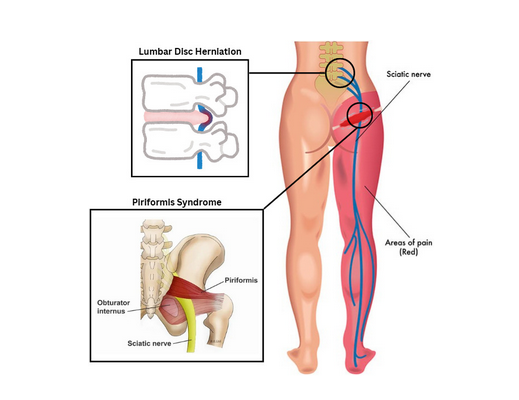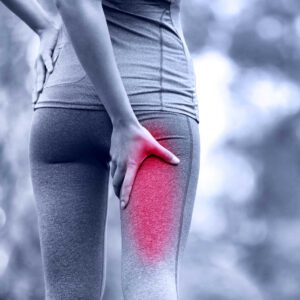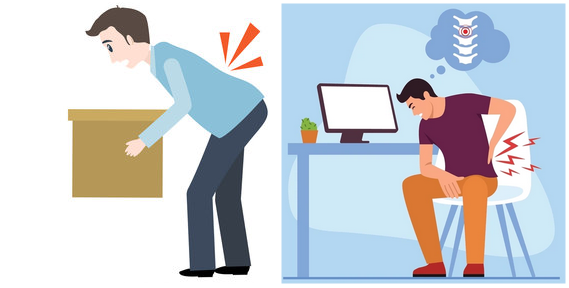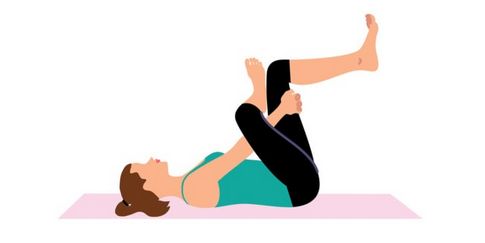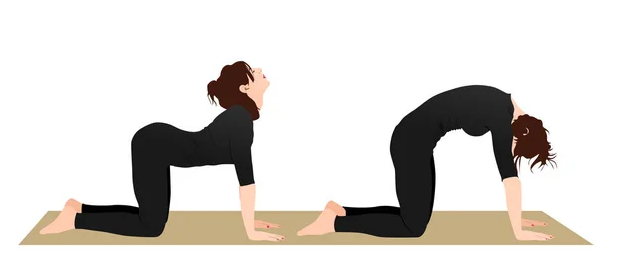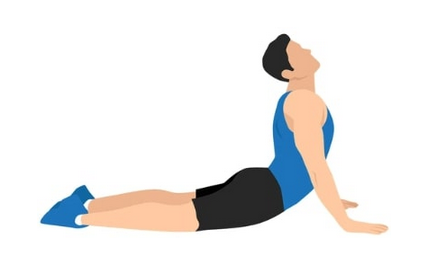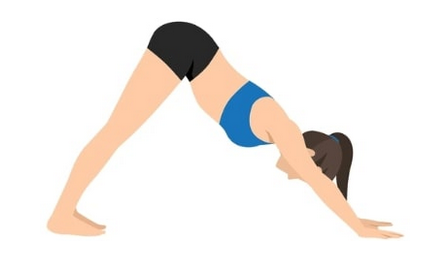Did you know that the sciatic nerve is the largest nerve in our body? It is about the size of our pinky finger! You might be curious why this is the case, and here’s the reason why. The sciatic nerve is formed by a bundle of nerve roots (L4-S3) that comes from your spine. It has to be long and thick enough to serve a wide area which includes the lower back, buttocks, and lower limbs.
When this nerve is irritated, it can cause sciatica which is described by many as pain radiating from the lower back down through the leg. In this guide, we’ll explore the causes, symptoms, and effective treatments for managing sciatica, helping you regain comfort in daily activities.
Understanding What is Sciatica
The sciatic nerve starts in the low back, passes through the piriformis muscle in the buttocks and extends down the back of each leg. It plays a vital role in connecting the spine to the lower limbs. The sciatic nerve can be irritated at different points such as:
- the lumbar spine, caused by disc herniations and/or spinal stenosis
- the buttocks aka, piriformis syndrome
So, what does sciatica feel like? Patients with sciatica often come to us describing it as:
- Electric shocking or shooting pain travelling from the low back down to the leg
- Numbness or tingling sensation, particularly in the foot and calf
- Weakness in the muscles of the affected leg
Who is at Risk of Developing Sciatica?
Sciatica is not limited to older adults; it can affect individuals across all age groups. People who are at higher risk include:
- Individuals with physically demanding jobs that involve heavy lifting or repetitive motions
- Individuals with sedentary lifestyles.
- Athletes or individuals engaging in high-impact sports (eg: rugby)
- Pregnant women due to changes in the pelvis to accommodate the little one
- Individuals who are overweight, as excess weight puts additional stress on the spine.
A Multidisciplinary Approach to Treatment
Relying on a single treatment approach often falls short because sciatica stems from multiple factors, such as nerve irritation, inflammation, and muscle imbalances. A multidisciplinary approach addresses these issues from different angles, offering more effective and sustainable relief.
Chiropractic Care
Chiropractic care aims to identify the root cause of sciatica before developing a targeted treatment plan. Oftentimes it stems from the lumbar spine or piriformis muscle involvement. Chiropractic treatments may include:
- Spinal adjustments
- Soft tissue massage
- Advanced therapeutic modalities such as electrical stimulation, TECAR therapy and flexion distraction therapy
By improving spinal function and addressing misalignments, chiropractic adjustments help restore proper nerve function, leading to pain relief and improved mobility over time. Many patients experience reduced discomfort and increased flexibility after consistent chiropractic sessions.
Physiotherapy
Physiotherapy plays a vital role in managing sciatica by addressing muscle imbalances that leads to the irritation of the sciatic nerve. It aims to strengthen muscles, improving mobility, and enhancing posture by providing the following treatment approaches:
- Provide guidance to perform strengthening exercises in proper posture to stabilize the spine and hips
- Provide posture and ergonomic advices to minimize strain on the lower back
- Improve flexibility to relieve pressure on the sciatic nerve
- Incorporate nerve gliding exercises
Physiotherapy allows you to understand the relationship of the muscles and a proper exercise program can improve hip mobility which allows daily activities such as lifting heavy objects and sitting to be done pain-free.
Dry Needling Therapy
Dry needling is a therapeutic technique used to relieve muscle tension and trigger points. By inserting fine needles into swelling muscles, this approach helps to:
- Reduce muscle tension
- Improve blood flow and reduce inflammation
- Enhance overall mobility
Dry needling is particularly effective for addressing musculoskeletal conditions associated with sciatica. In some cases, chiropractors and physiotherapists may also be trained to perform dry needling as part of a comprehensive treatment plan.
Medical Management
Medical treatments often form the last line of defense for managing acute sciatica symptoms, particularly when the pain is severe or debilitating. Common options include:
- Nonsteroidal Anti-inflammatory Drugs (NSAIDs)
- Corticosteroid Injections
- Muscle Relaxants
- Surgical Intervention
These treatments provide temporary relief by reducing inflammation and relieving muscle spasms, allowing patients to engage in further therapies like chiropractic care and physiotherapy to address the root cause of sciatica.
However, in severe cases, surgical interventions such as microdiscectomy or laminectomy will be suggested to remove the sources of nerve compression and prevent further complications such as loss of bowel or bladder control.
Home Exercises and Stretches for Sciatica Relief
Regular exercises and stretches can help alleviate sciatica pain and prevent recurrence. Some effective options include:
Knee-to-Chest Stretch: Lie on your back, bring one knee toward your chest, and hold for 20-30 seconds before switching legs.
Piriformis Stretch: Sit with one leg crossed over the other and gently pull the knee toward your chest to stretch the piriformis muscle.
Cat-Cow Stretch: Alternate between arching your back upward (cat pose) and lowering your belly (cow pose) while on all fours.
Hamstring Stretch: Extend one leg and reach toward your toes while keeping your back straight. If it is too difficult to do so, use a towel or resistive band to pull the foot towards yourself.
Perform these exercises daily or as recommended by a healthcare professional to maintain flexibility and reduce pain.
Lifestyle Modifications and Supplementary Therapies
Adopting healthier habits can further enhance recovery and minimize the risk of sciatica recurrence. Key lifestyle changes include:
1. Diet and Weight Management
Maintaining a healthy weight reduces pressure on the spine. Incorporate anti-inflammatory foods such as leafy greens, fatty fish, nuts, and berries. Limit processed foods and sugar, which can worsen inflammation.
2. Supplementation
Certain supplements can support nerve health and reduce inflammation, including:
- Vitamin B12: Promotes nerve repair.
- Magnesium: Relaxes muscles and reduces tension.
- Omega-3 Fatty Acids: Offers anti-inflammatory benefits.
Always consult a healthcare provider before starting new supplements.
3. Physical Activities like Yoga
Yoga improves flexibility, strengthens muscles, and reduces muscle tension. Poses such as Child’s Pose, Cobra Pose, and Downward Dog are particularly helpful for relieving sciatic nerve pressure. Regular practice also promotes better posture and body awareness. To ensure safety and effectiveness, yoga sessions should be guided by a professional instructor or experienced trainer who can provide modifications and proper techniques tailored to individual needs.
Child’s Pose
Cobra Pose
Downward Dog Pose
4. Ergonomics and Posture
Proper posture and ergonomics are essential for preventing sciatica. Tips include:
- Use an ergonomic chair with lumbar support.
- Keep your feet flat on the floor and your knees at a 90-degree angle.
- Take regular breaks from sitting or standing to stretch and move.
- Practice proper lifting techniques by bending at the knees and keeping your back straight.
- Incorporating these modifications can provide long-term relief and prevent future episodes of sciatica.
Taking the Next Step Towards Relief
Each of us is built differently, with unique physical demands and lifestyles that contribute to varying presentations of sciatica. This means that the underlying causes and best treatment approaches can differ from person to person. Instead of a one-size-fits-all solution, the key to effective recovery is a personalized approach.
If you’re experiencing sciatica, we encourage you to book an appointment with us. Together, we can assess your condition, identify the root cause, and determine the most suitable treatment plan, whether it involves chiropractic care, physiotherapy, medical interventions, or a combination of these. Our goal is to provide tailored care that best supports your recovery and long-term well-being.
Terri Chung
Chiropractor
Insight Chiropractic & Rehabilitation
Reach out to us by visiting insightchiro.com or contact 03-78878806. You may also make an appointment here.



